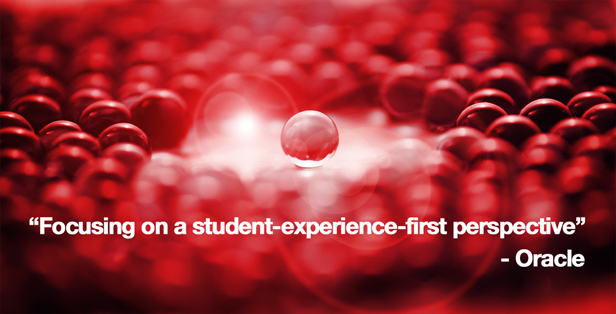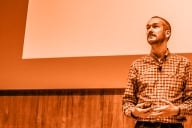You have /5 articles left.
Sign up for a free account or log in.
When I wrote a post on Connecting Technology Buckets in Student Affairs last year, I asked any and all technology companies to share their thoughts on connecting disparate data "buckets" in higher education. 14 comments later, a variety of comments and ideas were presented.
The last comment was submitted by Cole Clark, Global Vice President of Education and Research at Oracle. Knowing surprisingly very little about Oracle's higher education efforts, I followed-up to find out how Oracle is trying to use technology to improve the student experience. Thanks to Cole and his team for getting back to me with some well-thought-out answers:
How does Oracle (from big picture to in the trenches) actually measure improvement?
In the past and continuing today, higher education institutions struggle with providing the modern user experience which students, faculty, and staff are increasingly demanding. Disparate legacy systems have fueled a cumbersome and paper-based experience between higher education users and administrative systems. Today, many universities do not have a comprehensive approach to providing a frictionless experience and are not investing in a strategy to build critical relationships with their constituents.
To help institutions meet this challenge, Oracle is delivering new solutions for the cloud along with the adoption of a simplified and mobile first design strategy. This is a fundamental shift in thinking about how to approach IT systems - focusing on a student-experience-first perspective rather than simply enabling various transactions. With this approach, interaction with an institution should be simple and organic in nature students, faculty, and staff shouldn't even have to think about the fact that they are working with their university rather than say their bank or other online service provider. By achieving this simple, modern, holistic, and mobile-first approach, the improvement is obvious.
We certainly have internal measures we use to evaluate progress in the development of our products, and the ultimate measure is our success in the marketplace, but we also look at improvement from the customer side of the equation, evaluating how effective higher ed leadership is at changing the culture from a siloed approach to student experience to one that looks at it across the entire academic enterprise - from prospect to enrolled student to alum. This is also becoming more a loop rather than a straight line progression, as individuals interact with the education "ecosystem" at different stages of their lives.
What does friction-reduction look like?
Many institutions have focused on enabling mobile strategies, and/or marketing strategies, and /or social strategies or cost IT transformation strategies, but these too often are done independent of each other. What they are trying to do is improve the student experience, but to do that all these initiatives must be coordinated and be synergistic. Institutions should first develop a vision of what they want their student journeys to be across integrated student processes. Once this is established, they can focus on implementing solutions that support a truly frictionless, simple, and omnichannel experience.
Let me provide an example of an ideal, frictionless user experience (a scenario that we are still working toward today with our higher education institution partners). A current student is ready to start the normal registration process. As a first step, rather than ask the student to search for classes they may be interested in or required to take, a modern system could proactively provide class suggestions based on a series of criteria including the student's current major, classes they may be more likely to pass, or their past course selection. As a next step, the system could provide an easily navigable calendar that would enable them to map out their class schedule to determine which classes would work best from a timing perspective. Once they have confirmed their course load and fully registered, they can add their classes to a check out cart where they can easily and quickly pay. If they then need to update an element of their financial aid they can address it at that point as well.
Taking this ideal and seamless experience one step further, institutions can enable students to access services such as registration on their mobile devices. This would enable students to start the process on one device, continue the process on their desktop, and perhaps complete the process on their laptop or iPad. Again, this is a best case scenario for a frictionless experience, but it is one we think can become reality very soon.
What is the educational flow like from Oracle techs to staff/faculty to student?
Oracle will work with an institution to journey map a student experience. Oracle consultants or our partners will work with the institution to identify what the school wants the student experience to be, then determine what solutions/technologies are needed to deliver that experience. Also key to the effort is to assist the institution in developing the return on investment and cost justification models, as well as key performance indicators and success monitoring processes.
Once Oracle and its consulting partners work with the teams at universities, the goal is for students, faculty, and staff to seamlessly adopt the new solutions and functions without any formal training or education program. To help with this, Oracle can embed simple training guides and video tutorials that users can leverage to familiarize themselves with the new systems. This change in the approach to enabling users from a heavy-weight training investment to light, embedded user assistance is another positive result of leveraging cloud applications.
What have been consistent issues for the user experience team?
When working with higher education institutions, we often hear of several challenges they face. For example, operating in stove-piped IT infrastructures, sharing data across multiple departments, and establishing uniform business processes across departments. More recently, we have been hearing about the issue of data and insight gathering. Today, institutions are acting more as data stewards or safe-guarders, but they would like to act more like data curators. Their goal is to more completely leverage the data they have aggregated about their constituents so more university administrators and officials can use the insights provided by the data to provide better services across the various departments.
Does Oracle have a user experience team?
Yes, Oracle established its Applications User Experience team in 1999, and has since grown it into a global design organization with usability labs around the world. The professionals include research designers and usability engineers that are skilled in interviewing and interacting with our customers' students and other professional users to understand the challenges they face as well as their preferences. All of the Oracle user experience team members are focused on enabling the next evolution of the Oracle user experience - the simplified user interface for all Oracle applications - that embraces three themes that are increasingly important for today's higher education institutions and users: simplicity, mobility, and extensibility. Oracle is extremely proud of the breadth and depth of our user experience offering and we are continually investing and innovating in these areas to ensure the tools are easy to use and are "device aware" (i.e., tablet, smart phone, or traditional PC).
What kind of user testing is done to figure out use patterns before an app reaches a student?
As we mentioned above, we have a team of Oracle professionals focused on interfacing with students and other professional users to understand how they work, what applications and functionality will be helpful, and the challenges they face that our technology can help address. We embed our team members within the student, faculty, and staff to understand how they work and how they get their jobs done. Beyond that core research, we run usability testing as we design the solutions and applications. Further, we iteratively refine testing as we work with all applications in our product families.
What would you ask Oracle? How are you working to connect technologies at your campus in order to improve the student experience?
Do you tweet? Let's connect. Follow me on Twitter.





